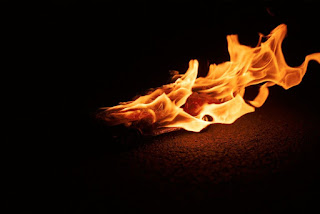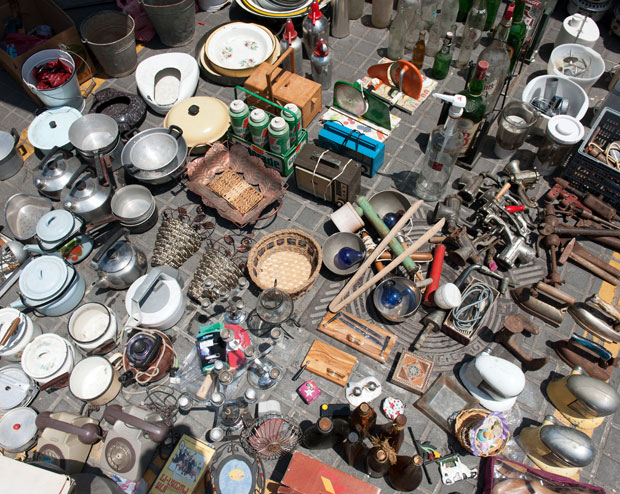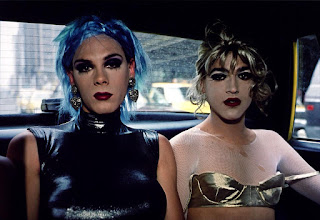Tuesday, October 31, 2017
Anna Brown reviews Pamela Littky
Pamela Littky is a Los Angeles, CA based
photographer who has worked with editorial type photography to document
well-known musicians and other celebrities, as well as capturing the less
iconic side of American culture via imagery of small town beauty pageants and
carnivals. She received her BFA from the
University of Arizona, and her works have been exhibited widely. Littky’s
unique and compelling eye influences her compositions, and her sense of humor
is apparent in the way she captures the individuals she works with. For
instance, in her Accountants series, I found her image of ‘Gary’ to be humorous
in that she portrays an individual who seems equal parts indifferent and
mundane. The look on his face, to me, reads as though he has done a routine
task a million times over, and he is trying to explain how he feels in one
expression. Littky is proficient in a variety of formats, and I think that is what makes her an excellent photographer.
Jacqueline Martinez Reviews Anne Hardy
Anne Hardy is a British artist that uses photography to manipulate spaces in order to have the space appear to be abandoned. She constructs these sets in her studio and through photography she captures a image that would be believable if they were to be observed up close. This is shown well in her work, Lumber, 2003-04, where her construction doesn’t look fabricated. Anne Hardy includes objects that have either been discarded or no longer serve their original purpose. Within Lumber, Christmas trees are included in the space, this creates a makeshift storage room. In this case, because of the fact that the Christmas trees are overwhelming the interior space, it leads to questions as to what lies beyond the trees.
Lumber, 2003-004
What I found interesting about Anne Hardy’s Lumber, was the fact that she gathered discarded objects and brought them into a staged environment. Anne Hardy chooses not to document these objects in the area where they were found but, to give them a new purpose in a new environment.
Jacqueline Martinez Reviews Zhang Huan
Zhang Huan’s work is known to reference the history of his native China, ranging from political to religious in China. He involves himself within his work by challenging his own endurance, physically and mentally. Photography is serves the purpose of capturing the final work of his performances. Zhang Huan’s To Raise the Water Level in a Fishpond, 1997, Zhang Huan gathered a group to stand in a pond in Beijing Park. Through this action he plays off a Chinese saying, “the effect that one person cannot make a difference in a larger environment”. Although by the law of physics the gathering of these people had no actual effect on the water level.
To Raise the Water Level in a Fishpond, 1997
To Raise the Water Level in a Fishpond (Waterchild), 1997
What I found interesting about Zhang Huan, is that during the time of his performances, artistic practice was outlawed in China. Performance art during this time was not supported by art institutions. This being said Zhang Huan, along with other artists; including Ma Liuming and Rong Rong, pushed the human body to its limits during performances. Zhang Huan’s performances were usually stages for a small audience or performed elsewhere.
Monday, October 30, 2017
Margarita Espinoza Reviews Lorna Simpson
Lorna Simpson is a conceptual photographer born 1960 in Brooklyn, New York. She is famous for her photographic work that addresses social issues such as gender, culture, and identity and how they affect interactions and relationships in American society. The Museum of Modern Art’s online collection includes a piece of Simpson’s artwork titled May, June, July, August ‘57-’09 which is a set of 307 individually framed photos. In this piece Simpson mimics a collection of authentic photos from 1957 that she found on eBay of an random woman in suggestive poses, each old photo is paired with a gelatin silver print featuring the artist herself in place of the original woman. Because the feminist artist is known for her work concerning the black female identity, the unknown woman’s photos alongside her own photos have no extra contextual information in order to encourage the viewer to create their own assumptions about the subject based on their appearance and the stereotype that apply.
I find this collection interesting because the artist is using historical artifacts in a contemporary fashion. The original photos in this collection are obviously posed but also have a candid quality that is apparent in the background information that Simpson also recreates in her renditions that I find successfully executed as well as aesthetically pleasing. The delicate physique of women from the iconic 1950’s era is replicated in Simpson’s photos that I find comforting as a viewer.
Margarita Espinoza Reviews Helmut Newton
Helmut Newton (b. 1920) is a German photographer that was born to a Jewish family that escaped Nazi oppression as a teenager in 1938. Newtown is famous for shooting high fashion, editorial photographs of models and celebrities while also incorporating “taboo” themes that lead his work towards the contemporary. His work consists of “dramatic lighting and unconventional poses of his models”. His professional work was featured in big name magazines such as Vogue, Playboy, and Elle. In Newton’s later years he published multiple photobooks focusing more on contemporary narratives that include themes such as eroticism, violence, prostitution, and sadomasochism that coincided with his editorial shooting style.
I find Helmut Newton’s work interesting because he can capture the fetishized nature of human sexuality and make it look glamourous and beautiful. The crude nature of these erotic themes suggest that women are allowed to be provocative which is an idea that has been rejected by society. Newton said, “I think the woman who gives the appearance of being available is sexually much more exciting than a woman who's completely distant. This sense of availability I find erotic.”
Thursday, October 26, 2017
Margarita Espinoza Reviews Zoe Leonard
Zoe Leonard’s (b. 1961) installation Analogue is a photo based installation that was exhibited at The Museum of Modern Art in 2015. This work included a series of gridded photos separated into 25 chapters, totaling in 412 photos taken over the course of a decade. Beginning in the 1990’s, these photos captured the “disappearing [mom-and-pop] store fronts and neglected products” while representing the global circulation of merchandising and capitalism throughout the turn of the 20th century into the 21st. To continue with the theme of “obsolete technology”, Leonard used a 1940’s Rolleiflex camera with gelatin silver and chromogenic printing processes. The artist is using the documentation aspect of photography and combining it with a contemporary composition to provide the audience with a true but also engaging and conceptual experience.
I find this exhibition interesting because it consumes the entire room which parallels with physicality of globalization and circulation. Most of the photos in this installation include text, which requires the viewer to interact with the images as well as creating a connection to them. There is also comforting sense of nostalgia from seeing photos of old store fronts from iconic eras even though not everyone (including me) is old enough to remember them. The familiarity of a mom-and-pop business is a universal idea that is relevant to people all over the world and there is an importance and appreciation for the artists attempt to conserve those places.
Margarita Espinoza Reviews Philip-Lorca diCorcia
Philip-Lorca diCorcia is an American photographer born in 1951 that is known for capturing the truths and fictions within a photograph. The artist works in medium-scale chromogenic color prints. DiCorcia chose authentic people and places but would precisely orchestrate the setting of his photos as a way of conceptualizing the idea of photos as historical documentation. Instead of allowing the photos to be honest with the audience, the artist emphasized the dramatic nature of his staged composition. DiCorcia said, “And what medium has a stronger relationship to people’s idea of the truth than one that is supposed to be an accurate representation of reality?” The mixture of truths and fictions allow the audience to create their own narratives to coincide with these images.
I find this artist interesting because of the cinematic and narrative qualities that his work suggests while also providing evidence of experience and process with the random people and places he chooses to capture. Knowing the context and the nature of these photos I am also drawn to the importance of the props and placement which would otherwise be unintentionally captured or overseen.
Eddie Anderson; 21 Years Old; Houston, Texas; $20. 1990-92.
“He photographed male prostitutes he approached on Santa Monica Boulevard, paying them whatever they typically charged for their services to instead pose in scenarios he had prepared for the photo sessions” (MOMA).
Gerald Hughes (a.k.a. Savage Fantasy); about 27 years old; Southern California; $50. 1990-92.
Bruce and Ronnie, 1982.
Margarita Espinoza Reviews Edward Weston
Edward Weston was born 1886 in Highland Park, Illinois. He is a photographer known for his close-ups, nudes, and landscapes as well as being the first photographer to receive the Guggenheim Fellowship for experimental work (1936). Weston began his career in California where he would travel door-to-door and photograph for families and funerals. Soon after he attended the Illinois College of Photography and eventually opened his own portrait studio where he became a notable, award-winning photographer. The “turning point” in Weston’s career happened in the ARMCO Steel Plant in Ohio where he discovered the “abstract form and sharper resolution of detail”. After this turning point Weston wrote, “The camera should be used for a recording of life, for rendering the very substance and quintessence of the thing itself, whether it be polished steel or palpitating flesh”. In the following years Weston will go on to explore nude photography, landscapes, and monumental close-ups of organic materials until his death in 1958.
I find this work engaging because of the high contrast of values, attention to fine details, and sculpture-like qualities that the artist applies to his subject matter. Weston emphasizes the natural textures and uses specific lighting to portray vegetables as seductive figures.
Wednesday, October 25, 2017
Henry Lopez Reviews Julien Magre
Julien Magre is a French photographer born in 1973. His main focus is to conduct narratives that surround his life, almost documenting it, but is careful to only give the viewers what he wants to show. In a lot of the works he wants the viewer to draw their own conclusions and fill in the gaps. In this series titled " Troubles", Magre creates beautifully composed images that vary from snapshots to cinematic frames. They document this trip of a family on empty roads and random hotels. They are dark and mysterious, even ominous, but then they have a dream like quality that pulls you in and makes you wonder what could be going on during this trip.
Each images has a different feel and look to it, there are landscapes, portraits, random objects and rooms. The whole collection of work is also edited differently; some are dark, some look to be negatives, some are color graded. It is almost hard to piece Margre's images together, but when in a sequence they are like flashes of memories and you start to see this ordinary trip go to what looks like a dark ending.
Each images has a different feel and look to it, there are landscapes, portraits, random objects and rooms. The whole collection of work is also edited differently; some are dark, some look to be negatives, some are color graded. It is almost hard to piece Margre's images together, but when in a sequence they are like flashes of memories and you start to see this ordinary trip go to what looks like a dark ending.
Hector Vasquez Reviews Cindy Sherman
Cindy Sherman is a photographer who's style of photography is more performance photography.
She photographs herself mostly, dressed up in various and wild costumes and makeup and characters. She takes these photographs to show how women fit in society and in art.
In this photograph entitled "Untitled #424", Sherman dresses as a clown and dons fake teeth. She used digital art to create different environments behind her. She would also place herself in front of a rear facing projections of land and cityscapes. For this photograph it is apparent that she used digital tools to create this rainbow colored background. www.artblart.com
Jasmine Barrios Stephen Shore
Stephen Shore work has been exhibited for about forty-five
years, throughout the years Shore has embraced various changes that have
happened with photography. He began shooting with cheap automatic cameras, then
moved to film, digital, and now has embraced the use of social media and has
used Instagram to display his photos. However Shore has remained consistent
with what he photographs. He first began
traveling and shooting in the 1970s and he has recently exploring Israel, West
Bank, and Ukraine. He typically shots everyday life and scenery from the city
he is in or he takes shots of items that he feels portrays the culture of his
surroundings.
Margarita Espinoza Reviews Nan Goldin
Nan Goldin was born 1953 in Boston, MA. She is a contemporary photographer that is known for exploring themes within love, gender, domesticity, and sexuality. Her career began at 18 when she “fell in with the drag queens”. She lived with many drag queens in downtown Boston and photographed her life among them. She attended the Tufts School of the Museum of Fine Arts in Boston; after graduation she moved to NYC and continued to photograph LGBT-related themes throughout the post-punk new-wave music scene in the late 1970’s. Her work continued on throughout the late 1990’s.
Nan Goldin’s photography styles can be described as a snapshot aesthetic. Her work is displayed in a series of photobooks that are dated between the 1970's through the 1990's. All of her photos are candids taken from her personal life and the people around her, she believed that her photography was “proof that [she] lived, and no one could revise it”.
In an interview Nan states, “I didn’t care about good photography, I cared about complete honesty”. She said, “it was a sin to move a beer bottle”, she never adjusted anything or staged any of her photos because she wanted her images to show exactly what was going on in her life.
Jimmy Paulette and Tabboo! undressing, NYC
1991
Nan one month after being battered
1984
Misty and Jimmy Paulette in a taxi, NYC
1991
Jacqueline Martinez Reviews Bernd and Hilla Becher
Two German photographers; Bernd and Hilla Becher, were known for their documentation of industrial landscapes. The documentation consists of “water towers, grain silos and gas tanks”, using the deadpan technique. Bernd and Hilla Bechers’ style of photographing serves as a “visual case study”, which is connected to the technique used. Their works draw from Conceptual Art which includes, minimalism and repetition.
Winding Towers (Britain) 1966-97
Their works represent different examples of the architecture structure across different locations. The prints are arranged in a grid system to show the differences between the architecture structures. What's interesting is that their series take years to photograph, this can be contributed to the traveling they take in order to capture different architectural structures. The strength of Bernd and Hilla Becher works is that of using photography’s strength as a source of documentation.
Water Towers, 1972-2009
http://www.tate.org.uk/art/artworks/bernd-becher-and-hilla-becher-gas-tanks-p81237
http://www.artnet.com/artists/bernd-and-hilla-becher/
Subscribe to:
Posts (Atom)




































